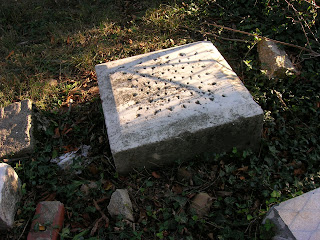 Note: I wrote this last fall for a grad school assignment but thought it fit the theme of this blog as well.
Note: I wrote this last fall for a grad school assignment but thought it fit the theme of this blog as well.
Last September, I passed shops, businesses, and luxury condominiums on
Along with the buzz and clink of a mechanic’s work, I heard traffic and the occasional ambulance siren. On a different day, I might have heard children playing or multiple conversations coming from the YMCA which curved around two sides of the cemetery. A colorful playground, covered picnic area, and metal bleachers could be seen through the fence. Mysteriously, the bleachers were pushed against an unrelated gray building with the lowest bench first. Any spectators would look blankly at the equally blank gray wall.
Decaying leaves spotted the cemetery ground, making it a musty faded green
The surviving individual grave stones were pushed to the far left corner of the site, several feet from the new stone. They were run down or toppled over, broken and faded. One stone had multiple holes in it, as though it had been machine gunned. A tombstone graveyard.
 The Old Ball Family Burial Ground is one of many historic family plots in
The Old Ball Family Burial Ground is one of many historic family plots in
Despite it being a run down version of its former self, the Ball graveyard still had much to tell. Two grave markers revealed especially short lives. Emma Marcey died 11 days after her 13th birthday on October 31, 1875. Catherine Donaldson died before her first birthday in 1894. Flowers, which often symbolize life’s frailty, were at the top corners of the gravestone. Her parents, James and Sarah, were also identified on the stone to shed some light into this stunted life. Other gravestones simply had letters, such as
The most prominent among the clustered group was John Wesley Boldin’s stone; it was the highest, at three feet, and the most elaborate. The white tombstone depicted a profile view of a knight holding two crossed axes and a shield. A bird, which resembled a crow, stood on top of his helmet. This was probably because of John’s service during the Civil War. I could make out the dates, 1843-1908, and some of the words, “Sacred…to the memory of our dear husband and father.” His wife, Ella Jane Boldin, daughter of Mary Donaldson née Ball, would be one of the last to be buried in the cemetery, in the spring of 1948. She was 93.
Mary Thrift Ball was the first person to be buried there. She died on October 10, 1804. She was 55.
The cemetery was part of 12.5 acres that had been granted to Mary’s husband, John Ball, on August 4, 1789. According to census records, they lived there with their eight children and at least two slaves. The log house John built stood on the south side of
John was a notable figure in the community. He was an acquaintance of George Washington and an early supporter of the Revolution. In 1770 he, along with his brother and father, signed an agreement not to import British goods. He also served in the Sixth Virginia Infantry during the war.
I could not find Mary or John’s gravestones, though many were indiscernible. Only ghostly marks and smudges remained of messages that once held significant meaning for those who commissioned them. Aldous Huxley once said, “The only completely consistent people are the dead,” but even that could be argued in the Bal
Without the markers in their original places, I had to trample over the dead. I could not stand next to a grave and contemplate the life of the person laying just a few feet under me. With the knowledge of that physical proximity, I feel somehow connected to his or her life. I think about what it must have been like to live and breath in the period encompassed by the two simple dates that, along with a name, might be one of the few records left demonstrating that the individual existed at all.
I try to imagine what last words were spoken before the fresh dirt hit the sunken caskets. People were probably standing solemnly, some grief stricken, others attending out of a sense of obligation. On holidays and anniversaries, the grieving probably came back to knell on the same grass. They placed flowers, which eventually decayed into the ground, year after year, until their own tombstones sprouted.
###
Even though it has been damaged, the Old Ball Family Burial Ground has had a better fate than most
Sara agreed to meet me in the
She said Marie probably had all the remaining stones moved to the left corner because, due to vandalism, many of the stones had already been moved. I asked her about the types of people that would go out of their way to mess with a cemetery, and we chuckled quietly as we tried to envision their motivation.
###
I visited the site again in early November, after jack-o-lanterns had been trashed and spooky fake spider webs had been stored in the holiday section of basement closets. It was chilly. The red scarf and yellow rubber ball I saw during my last visit were gone. Half of a dirty paper plate and a yellow plastic spoon were among the graves, probably remnants of a recent YMCA event. The wind tickled the leaves and rustling was added to the cascade of city noises. Birds squawked painfully nearby.
1 comment:
What a wonderful story and history. Thanks so much for sharing it.
Post a Comment